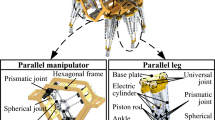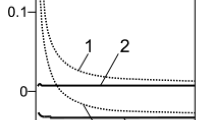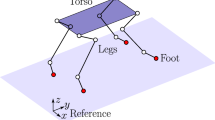Abstract
Legged machines designed to walk on flat or irregular terrain do not need to possess great foot positioning accuracy in order to perform stable motion. However, the propulsion of the body—which normally follows a straight line—, requires feet to follow perfect straight lines—in the body's reference frame—, which must be parallel to each other; otherwise internal foot forces will arise. When this occurs, mainly due to mechanical imperfections and kinematic inaccuracies, foot slippage and changes in the attitude/altitude of the vehicle appear. In the case of legged robots that need to move on rigid structures to achieve stable locomotion, precise foot positioning is required to reduce the foot force interaction. Examples of such robots are legged robots that move by grasping structures or climbing robots that clasp their feet to a wall. Kinematic calibration is a traditional method of improving the accuracy of robot manipulators. These techniques, especially those based on kinematic closed chains, can also be applied to legged robots. This article introduces a method for calibrating legged machines autonomously. The theory has been developed to control a special four-legged robot, and for calibrating purposes each leg has been considered as a 2-DOF leg. Nevertheless, the theory can be easily extended to 3-DOF-leg machines as well as to six-legged machines. The method is of particular interest for industrial machines that walk on rigid structures so that the feet clasp firmly and cannot slip. The method is evaluated through simulation and tested in an industrial four-legged machine developed to walk in a double bottom cell of a ship's hull. Some experiments have been conducted using the calibrated kinematic model to validate the usefulness of the calibration method.
Similar content being viewed by others
References
Bares, J. and Whittaker, W. 1993. Configuration of autonomous walkers for extreme terrain. Intl. J. Robot. Res., 12(6):535–559.
Bennett, D.J. and Hollerbach, J.M. 1991. Autonomous calibration of single-loop closed kinematic chains formed by manipulators with passive endpoint constraints. IEEE Transactions on Robotics and Automation, 7(5):597–606.
Berns, K. 1997. The walking machine catalogue. Available at http://www.fzi.de/ipt/WMC/walking machines katalog/walking machines katalog.html.
Bonitz, R.G. and Hsia, T.C. 1997. Calibrating a multi-manipulator robotic system. IEEE Robotics and Automation Magazine, 4(1):18–22.
Chen, I.M. and Yang, G. 1997. Kinematic calibration of modular reconfigurable robots using product-of-exponentials formula. Journal of Robotic Systems, 14(11):807–821.
Driels, M.R. and Swayze, W.E. 1994. Automated partial pose measurement system for manipulator calibration experiments. IEEE Transactions on Robotics and Automation, 10(4):430–440.
Gonzalez de Santos, P., Armada, M.A., and Jimenez, M.A. 1997. An industrial walking machine for naval construction. In Proc of the IEEE Intl. Conf. on Robot. and Automat, Albuquerque, NM, pp. 28–33.
Gonzalez de Santos, P., Armada, M.A., and Jimenez, M.A. 2000. Ship building with ROWER. IEEE Robotics and Automation Magazine, 7(4):35–43.
Grace, A. 1995. Optimization toolbox for use with MATLB. The Math Works Inc.
Grieco, J.C., Prieto, M., Armada, M.A., and Gonzalez de Santos, P. 1998. A six-legged climbing robot for high payloads. In Proc. of the IEEE Intl. Conf. on Control Applications, Trieste, Italy, pp. 446–450.
Hirose, S. 1984. A study of the design and control of a quadruped walking vehicle. Intl. J. Robot. Res., 3(2):113–133.
Judd, R.P. and Knasinski, A.B 1991. A technique to calibrate industrial robots with experimental verification. IEEE Transaction on Robotics and Automation, 6(1):20–30.
Legnani, G., Mina, C., and Trevelyan, J. 1996. Static calibration of industrial manipulators design of an optical instrumentation and application to SCARA robots. Journal of Robotic Systems, 13(7):445–460.
McGhee, R.B. and Iswandhi, G.I. 1979. Adaptive locomotion of a multi-legged robot over rough terrain. IEEE Transactions on Systems; Man and Cybernetics, 4:176–182.
More, J.J. 1977. The Levenberg-Marquardt algorithm: Implementation and theory. In Numerical Analysis, G.A. Watson (Ed.), Lecture Notes in Mathematics, vol. 639, Springer-Verlag: Berlin, pp. 105–116.
Mosher, R.S. 1968. Test and evaluation of a versatile walking truck. In Proc. of the Cornell Aeronautic Lab/ISTVS Off-road Mobility Research Symposium, Washington, DC, pp. 359–379.
Nagakubo, A. and Hirose, S. 1994. Walking and running of the quadruped wall-climbing robot. In Proc of the IEEE Intl. Conf. on Robot. and Automat, San Diego, CA, pp. 1005–1012.
Pugh, D., Riggle, E., Vohnout, V., Bihari, T., Walliser, T., Patterson, M., and Waldron, K. 1990. Technical description of the adaptive suspension vehicle. Intl. J. Robot. Res., 9(2):24–41.
Stone, H. and Sanderson, A. 1987. A prototype arm signature identification. In Proc of the IEEE Intl. Conf. on Robot. and Automat, Raleigh, NC, pp. 175–182.
Whitney, D., Lozinsky, C., and Rourke, J. 1986. Industrial robot forward calibration method and results. .ASMEJournal of Dynamic Systems, Measurements and Control, 108:1–8.
Zhong, X.L., Lewis, J.M., and Nagy, F.L. 1996. Autonomous robot calibration using a trigger probe. Robotics and Autonomous Systems, 18:395–410.
Zhuang, H., Wu, J., and Huang, W. 1997. Optimal planning of robot calibration experiments by genetic algorithms. Journal of Robotic Systems, 14(10):741–752.
Author information
Authors and Affiliations
Rights and permissions
About this article
Cite this article
de Santos, P.G., Jiménez, M. & Armada, M. Improving the Motion of Walking Machines by Autonomous Kinematic Calibration. Autonomous Robots 12, 187–199 (2002). https://doi.org/10.1023/A:1014001527611
Issue Date:
DOI: https://doi.org/10.1023/A:1014001527611




